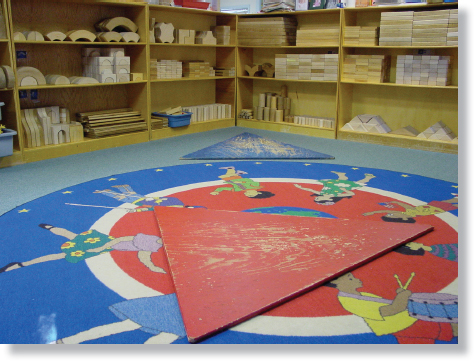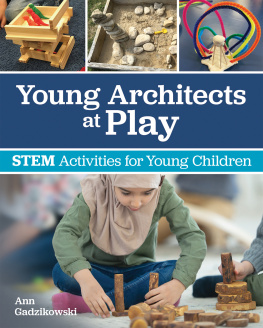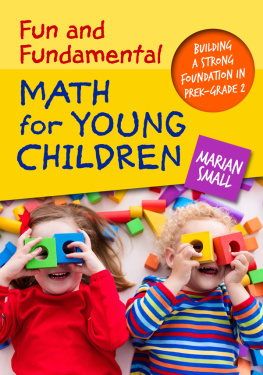Lets Build:
Strong Foundations in Language, Math, and Social Skills
by Pamela C. Phelps
DEDICATION
This book is dedicated to all children who have loved playing with the Creative Pre-School blocks and to the teachers who have made the experience unique, first Ms. Martha Pleas, and later Ms. Susan Brooks and Mr. Chuck Alexander.

2012 Pamela C. Phelps
Published by Gryphon House, Inc.
PO Box 10, Lewisville, NC 27023
800.638.0928; 877.638.7576 (fax)
Visit us on the web at www.gryphonhouse.com.
All rights reserved. No part of this publication may be reproduced or transmitted in any form or by any means, electronic or technical, including photocopy, recording, or any information storage or retrieval system, without prior written permission of the publisher. Printed in the United States. Every effort has been made to locate copyright and permission information.
Cover photograph courtesy of Kaplan Early Learning Co., Lewisville, NC.
Interior photographs: iStock photo LP 2011. All rights reserved. IStockphoto and iStock re trademarks of iStockphoto LP. www.istockphoto.com.
Library of Congress Cataloging-in-Publication Data
Phelps, Pamela C.
Lets build : strong foundations in language, math, and social skills / by Pamela C. Phelps.
p. cm.
Includes bibliographical references and index.
ISBN 978-0-87659-432-2
1. Early childhood education--Activity programs. 2. Language arts (Early childhood)--Activity programs. 3. Social skills--Study and teaching (Early childhood)--Activity programs. 4. Blocks (Toys) in mathematics education. 5. Blocks (Toys) I. Title.
LB1139.35.A37P44 2012
372.21--dc23
2012004313
Bulk Purchase
Gryphon House books are available for special premiums and sales promotions as well as for fund-raising use. Special editions or book excerpts also can be created to specifications. For details, contact the Director of Marketing at Gryphon House.
Disclaimer
Gryphon House, Inc. cannot be held responsible for damage, mishap, or injury incurred during the use of or because of activities in this book. Appropriate and reasonable caution and adult supervision of children involved in activities, corresponding to the age and capability of each child involved, is recommended at all times. Do not leave children unattended at any time. Observe safety and caution at all times.
Table of Contents
The block area in any and every childhood program can be a welcoming space for both boys and girls. Blocks are marvelous play materials that offer many learning opportunities. This book is for teachers who know and understand the learning potential of blocks and for teachers who know that books are valuable classroom materials but need help understanding why blocks are important and how to use blocks effectively (and playfully) in the classroom.
One person who understood and valued construction play with blocks was Carolyn Pratt, who designed the basic wooden unit blocks used in early childhood classrooms.

As Ms. Martha Pleas at the Creative Pre-School (19731998) explored the block-play possibilities with children, she would often say, Now when you use Ms. Carolyn Pratts blocks, you can make anything you want. Look at the pictures in your mind and make them out of her blocks.
Children who play at the Creative Pre-School in Tallahassee, Florida, have used the same set of Ms. Carolyns blocks for more than 40 years. Some of children who attend this school today are children of the first children who went to Creative Pre-School. Todays children play with the same blocks because blocks are an almost-forever toy. The sounds of joy and accomplishment fill the classrooms as children use their imagination to make blocks become whatever they want or need in their play. Many adults, who played with these blocks as young childrenboth boys and girlshave used the knowledge they gained from their experiences and applied it to their careers, which include architecture and engineering.
Pam Phelps, the author of this book, first started Creative Pre-School in 1971. Before children played in the block area, she would tell them about a woman, Carolyn Pratt, who wanted children in her school to have special things to play with. Dr. Phelps told the children about how Carolyn Pratt went to the docks of New York City and collected pieces of wood so children could construct the buildings and other structures they saw around them. Blocks were a major focus of the Beyond Centers and Circle Time Curriculum (2002), which was perfected at Creative Pre-School, where it remains a focal point today. The block center at Creative Pre-School offers children an array of more than 4,000 different kinds of blocks to use in their unique, imaginative constructions.
When children play with blocks, they have numerous opportunities to learn, develop, and refine mathematical knowledge and social and language skills. Playing with blocks is a golden learning experience.

In a world in which many play materials are designed for a single purpose with batteries that make them beep and sparkle with lights, nothing is left to the imagination of young children. When toys are designed to imitate the objects they represent, it limits how the toy can be used. Ideally, toys should give children open-ended opportunities to use their imaginations and creativity. Toys like blocks create numerous and varied ways to develop childrens minds.
David Elkind, psychologist, well-known advocate for children, and author of The Power of Play (2007), stresses the importance of play and the value of experiences that offer children opportunities to experiment with water, sand, and other natural materials. Wooden blocks are the ultimate natural play material for children. Holding a block and feeling its smooth finish, smelling its natural aroma, and seeing its earthy coloring is a very different sensory experience from interacting with a brightly colored plastic toy with an explicit design. In addition, block play gives children the ability to use their imagination to build and construct what they need for their play, to make plans, to carry out their plans, to problem-solve any challenges, to navigate roles and responsibilities with their co-builders, and to learn many other skills as they plan and build their constructions.
Children naturally do many of the things that help them grow and develop. The baby who is learning to adjust to his mother leaving and returning will engage in peekaboo games, and the three-year-old who is learning to enjoy the sounds of words will play with rhyming sounds as she soaks in the tub of bubble water at night. When adults guide and support children who are developing a new or difficult-to-learn task or developmental milestone, true learning can take place. Perhaps this is what Jean-Jacques Rousseau, an eighteenth-century philosopher, observed in the behavior of young children that led him to believe in their innate abilities to learn and develop.
Recently, some aspects of brain research along with federal and state legislation have created an educational environment that focuses on the memorization of specific knowledge and diminishing opportunities for play. Research shows, however, that well-planned play opportunities with teacher guidance and support (also called scaffolding) provide the best of both worldsa world in which the specific information children need to know, such as number knowledge, phonemic awareness, and print awareness, can be embedded into meaningful play (Hanline, Milton, and Phelps 2009; Berk and Winsler 1995; Christie and Roskos 2006). Young children whose early experiences include reading books, conversations about what is happening, and time to explore and discover the things in their lives that interest them, may not need as much teacher guidance and support as they play.







